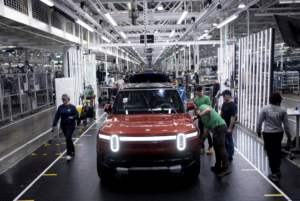Rivian Facing Challenges: What Investors Need to Know
Rivian (RIVN) hit a bump in the road with its latest third-quarter earnings report, revealing lower revenue and a wider-than-expected loss. The pure-play adventure electric vehicle maker cited supplier parts issues as the cause for its difficulties. Despite projecting a larger loss for the year than initially anticipated, Rivian still expects to deliver a “modest gross profit” in the fourth quarter.
In the third quarter, Rivian reported revenue of $874 million, falling short of the $980 billion expected by Bloomberg consensus. This marked a decline from the $1.34 billion generated the previous year. Additionally, the company reported an adjusted loss per share of $0.99, compared to an expected loss of $0.92, and an adjusted EBITDA loss of $757 million, higher than the $657.5 million expected.
Following the earnings release, Rivian stock dropped in after-hours trading, reflecting investor concerns over the company’s performance.
One of the key challenges Rivian faced was a production disruption due to a shortage of a shared component on the R1 and RCV platforms. This supply shortage began in the third quarter and has continued to impact the company’s operations.
As a result of these challenges, Rivian revised its full-year adjusted EBITDA guidance to a loss of $2.82 billion to $2.87 billion, exceeding the previously forecasted $2.7 billion loss. The company also adjusted its annual production guidance to between 47,000 and 49,000 vehicles, down from the 57,000 vehicles it had initially expected.
Despite these setbacks, Rivian maintained its annual delivery outlook, forecasting low-single-digit growth compared to the previous year. The company expects to deliver between 50,500 and 52,000 vehicles by the end of the year.
Looking ahead, Rivian expressed optimism about its future prospects, particularly with the upcoming launch of its midsize SUV, R2. CEO RJ Scaringe highlighted the progress made on the Gen 2 R1 cost structure and the potential for growth driven by the new model.
In terms of its financial position, Rivian ended the second quarter with $7.85 billion in cash and equivalents, providing a solid cash cushion to weather the current challenges.
One significant development contributing to Rivian’s cash position was a joint venture deal with Volkswagen (VWAGY) in the second quarter. Volkswagen invested an initial $1 billion in Rivian through an unsecured convertible note, with plans for up to $4 billion in additional investment by 2026. This strategic partnership is aimed at developing next-generation software-defined vehicle architectures for both companies’ future EVs.
Despite the recent hurdles, Rivian remains focused on its vision for sustainable mobility and innovation in the electric vehicle market. Investors will be closely monitoring the company’s progress and strategic initiatives as it navigates through this challenging period. Stay tuned for more updates on Rivian and other investment opportunities in the electric vehicle sector on Extreme Investor Network.

